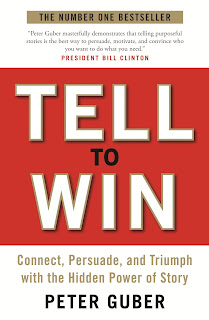TELL TO WIN BY PETER GUBER
The Book is about the strategic importance of appealing to people’s hearts in order to persuade others to support your vision, dream or cause, through story telling.
Non ‘stories’ may provide information, but stories have a unique power to
move people’s hearts, minds, feet, and wallets, in the story teller’s intended
direction.
For example, in film making, if you miss the
audience’s hearts, the only wallet that gets hit will be your own. That is
because the heart is always
the first target in storytelling.
If one is pursuing a cause that will improve
the life of others, for instance, providing clean water for kids in Somalia,
and one tells a story of how kids in this area die from lack of clean water and
such film is viewed by an audience of businessmen, it’s most likely going to
appeal to their hearts, and then the cheques of donors can start rolling out.
To
succeed, you have to persuade others to support your vision, dream or cause.
Whether you want to motivate your colleagues,
organize your shareholders, shape your media, engage your customers, win over
investors or land a job. You
have to deliver a clarion call that will get listeners’ attention, emotionalize
your goal as theirs and move them, to act in your favour. You have to reach
their hearts as well as their minds – and this is just what story telling does!
So
stories teach, model, unite and motivate by transporting audience emotionally. Story telling is a secret sauce of success,
it could be your past experiences, etc, that will endear others to your goal or
cause.
How
do you unite a disparate group to fight for their future when none believe they
can or should work together?
Answer: By moving every member to feel and therefore believe that
by pulling together, we all could gain in security, opportunity, achievement
and pride.
Find
below a story of resilience, being told by a CEO, to motivate his people. It is the story of a young boy with
crippling degenerative disease, who lived near him when he was growing up in
Boston.
“The boy’s speech was garbled. He couldn’t
walk and he wasn’t able to go to school like the rest of us in the
neighborhood. But I could see him at his window everyday watching us bicycle up
and down the block.
One day his father appeared on the sidewalk
hauling a bicycle with training wheels on the front and back. This six-wheeler
looked as if an elephant could ride it without falling. As I watched from my
window, the boy’s father carried him out, put him on the contraption. Then the
father went back inside.
The
kid started to pedal and in a minute the bike tripped over. I could see the
father in his window watching. So could the boy. His dad watched him lying
there and did nothing. Finally the boy pulled himself up and then
went about three feet and fell to the other side. Again the father stood
watching. For weeks, that kid
kept trying and falling and the father didn’t lift a finger. I complained to my
mother, but she told me to mind my business. I couldn’t, the drama was so
seductive.
One Saturday morning, the boy crashed off the
curb. I had to go down. But when I reached the sidewalk, the kid
waved me off. Then the father tapped on the window glass and shook his finger
at me to go away. Convinced, he must be some kind of monster, I left the boy
trying to pull himself up and ran back home.
Then a couple of days later, the kid was out
there again, over he went, and up he went again.
But
then suddenly he was rolling! He made about sixty feet then he turned around and
rode all the way back without falling. I looked up and there was a father
grinning down at his son. I looked up at the boy and he was beaming up at his
father. Then they both started laughing and waving like crazy. And I
started to cry.
Finally,
I got it! They both knew the boy needed to face the challenges and struggle
through it on his own. He needed to be his own agent of change, to be active in
his own rescue. If his father did it for him, the boy wouldn’t feel like a
hero. And only if he was the hero would this seminial victory
empower him to face the other inevitable and monumental challenges that lay in
this boy’s future.
The joy I felt in the kid’s little sixty-foot
bike ride was overwhelming, my experience of his unique challenge, struggle, and
triumph became an archetypal tale of persistence that I told myself every time
I face challenges. The story
of the boy taught me that failure really is just a speed bump on the road to
success. Heroes don’t quit, so the only true failure is the failure to get up.
This story’s call to action was to keep ‘getting up’.”




Comments
Post a Comment